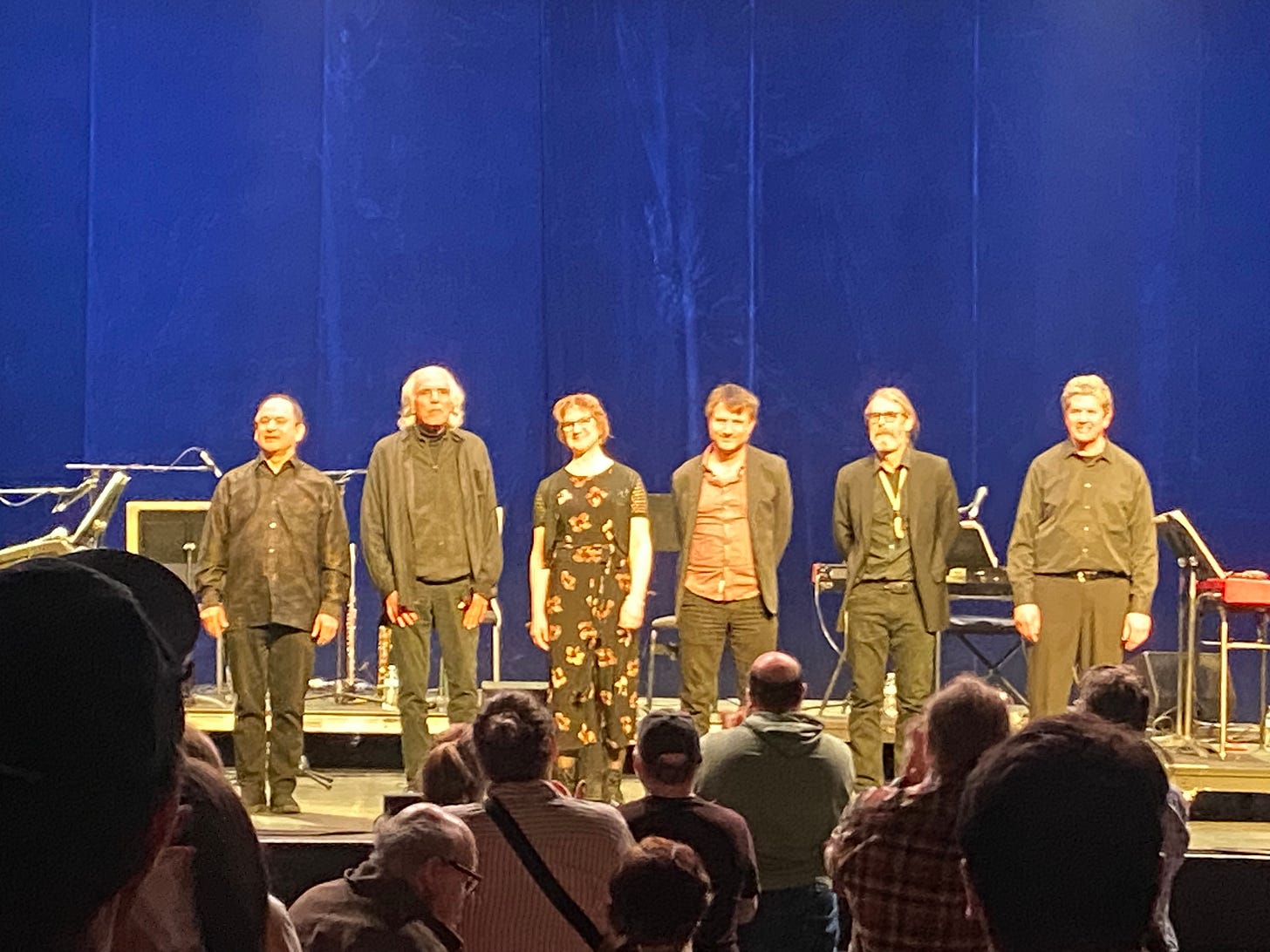Good timing this week. The final episode of Rearranged went up on Tuesday, but before I had time to be sad about it, I was on a flight to Knoxville, Tennessee for Big Ears Festival.
Today, the airline cancelled the second leg of my flight back to Baltimore while I was still in the air on the first flight. I lined up another flight, but with a few hours (and a NoDa Brewing Pitchside Pils) to kill at the Charlotte airport, I want to tell you about the highlight of the festival for me: the Philip Glass Ensemble's performance of the four-hour composition Music in Twelve Parts over two days at the Tennessee Theatre.
All melody works in counterpoint in Music in Twelve Parts. No tune suggests itself for taking home. Any given instrument—in this case, two or three keyboards at any given time, soprano voice, and three woodwind players choosing from soprano sax, alto sax, tenor sax, and flute—is usually locked in with another instrument. Those partnerships shift over the course of a piece.
It's redundant to say Glass is repetitive, but it, uh, bears repeating here. With different voices in different meters, the polyrhythms confine you like roots grown over your feet, and the musicians repeat phrases for so many measures that the inevitable slight variation startles you.
The work was programmed one hour at a time: parts 1-3, intermission, and parts 4-6 on Friday, and parts 7-9, intermission, and parts 10-12 on Saturday. I can only imagine the effect of four straight hours of this explicitly mesmerizing music. Each separate hour took me places music hasn't taken me in a long time.
I thought about nothing. I thought about whether the most loving thing you can do for a person is to be with them when they die.
I also thought about what I was seeing and hearing. When listening to music, you always have the option of "outside" listening—appreciating the cohesive whole work all at once—or "inside" listening: going inside the work to pay attention to individual elements, a part, the way someone is playing a part, the way one part reacts to another, the shifting relationships a player cycles through during the performance.
The repetition Glass creates in Music in Twelve Parts enables a listener to easily move from the outside to the inside and back. No player or part dominates, so the seeker of the outside view can easily isolate the entirety of the work and absorb it without the distraction of a lead voice. And the outside work might still be exactly the same when you come back out for it. (Sorry if this is "Minimalism 101" for you—I write as an enthusiastic listener, not an expert. This is why I actually enjoyed Ken Burns' Jazz.)
Above: The Tennessee Theatre, Knoxville.
In between the outside work and internal parts lie the patterns. Glass introduces variations so subtly, one player or "voice" at a time, that a transition to the next of the twelve parts, which the whole ensemble does in tempo without a rest, works like a jump scare.
The smaller variations assert themselves without rhyme or reason. They seem to emit compulsively. It's like the variations exist in the no man's land between OCD and Tourette's (which, as it happens, is a space I inhabited as a kid, so maybe I’m built for Glass). But even the most random sounding polyrhythm fails to irritate me, because Glass has thought through not just the math—the beauty of mathematics is constantly audible in this piece—but in the colors Glass creates by joining different instruments' timbres in the voices at a given point in a piece.
When you pause music, it goes away.
And here's where you see what my friend Lee Gardner called the magical nature of music in an interview he conducted at the festival. There is no "given point" in a work of music that you can observe in performance. As soon as you try to scrutinize a given moment, it's gone. A disappearing act. Haha! You wanted a closer inspection? Too bad!

You can pause a film and devote more attention to something in a shot that compels you. And certainly that's true with painting and still photography. But without the score, good luck doing that with music. When you pause music, it goes away.
By repeating elements for so long, Glass makes it easier for us to "pause" the music, to go inside and observe a given point. It's his own magic, or an antidote to music's magic. You can pause it. That phrase with the voice and saxophone: is it 9/8 or 5/4? Just keep listening.
Because no voice dominates, Music in Twelve Parts provoked me to a thought I'd never had. If you could drift just far enough into space and had some device that allowed you to hear every sound on earth at once, what would it sound like?
Humanity: what would it sound like at a given point in time?
I did eventually find the score for Music in Twelve Parts, and it confirmed something I’d suspected at the performance. Glass did not compose rests for the singer or woodwind players. The music, often long stretches of eighth or even sixteenth notes, just keeps going, relentlessly. Sometimes you'd hear something drop out at a seemingly random place. Then you'd look, and you'd see the singer or a woodwind player take a breath and jump back in.
In my rudimentary attempt to learn some composition, that's one of the first things I learned: don't write something a musician can't do. Write in their range. Consider the fingering on the instrument. And for christ's sake, put some rests in so they can breathe.
Why didn't Glass do this? It's not like it didn't occur to him, and if it hadn't, you can be sure a player—panting, blue in the face—would have told him.
In part III, Glass gave the singer and woodwind players no rests. None. Zero.
Is it some structural integrity to the intricate castle he'd built in the score? Or is it generosity? Is he giving up some control of the work to give the musicians some more control of their humanity, letting them breathe when they want to breathe rather than where a rest tells them they may breathe? I grew to love these blips in the performance, a little assertion of a human need. This also adds some humanity back to the score, because there is no room for variation or improvisation. No cadenzas for you, but you can breathe where you want!
It reminded me of Saturday Night Live, of all things (where Glass once performed). I just watched some of those documentaries Peacock made for SNL's 50th anniversary, and a couple times, people mentioned that improvisation was a big no-no. It's live TV, and 90 minutes is 90 minutes. Your improvisation might eat time that gets a later skit cut. You've got these players who mostly came out of improv ensembles like Second City and the Groundlings, and all they get to do are composed sketches. It imposes a rigorous discipline on people whose art, comedy, is often inspired by the abandon of discipline.
The discipline on stage at the Tennessee Theatre this weekend helped me unlock my mind, helped me abandon discipline for a few beautiful hours. I hope the Philip Glass Ensemble plays close to Baltimore sometime soon and plays this. I want to take as many people as I can.
Thanks for reading. Please head over to Apple Podcasts and subscribe to the Rearranged podcast. If you like it, please leave a review and share with your friends.






Yes! Chasing down missed performances/artists is a great idea.
I didn't go to this at Big Ears but enjoyed reading your thoughts. On the strength of your write-up I did just buy the Philip Glass Ensemble version re-released via Orange Mountain Music on Bandcamp (for the great price of $12). It's part of my Big Ears alternate timeline itinerary where your other self gets to see all the shows you missed.